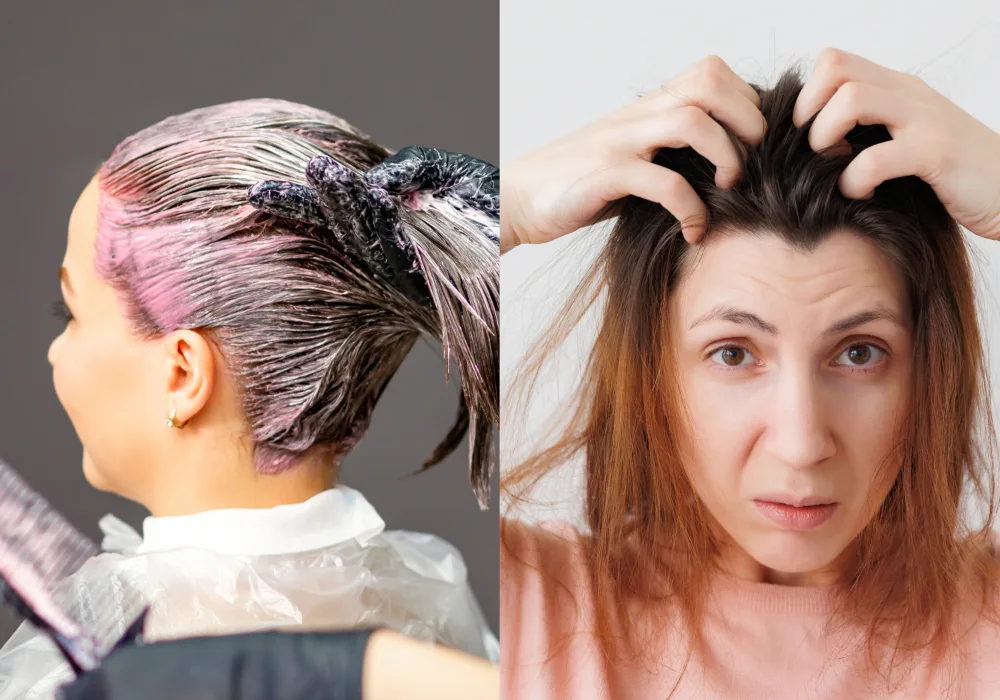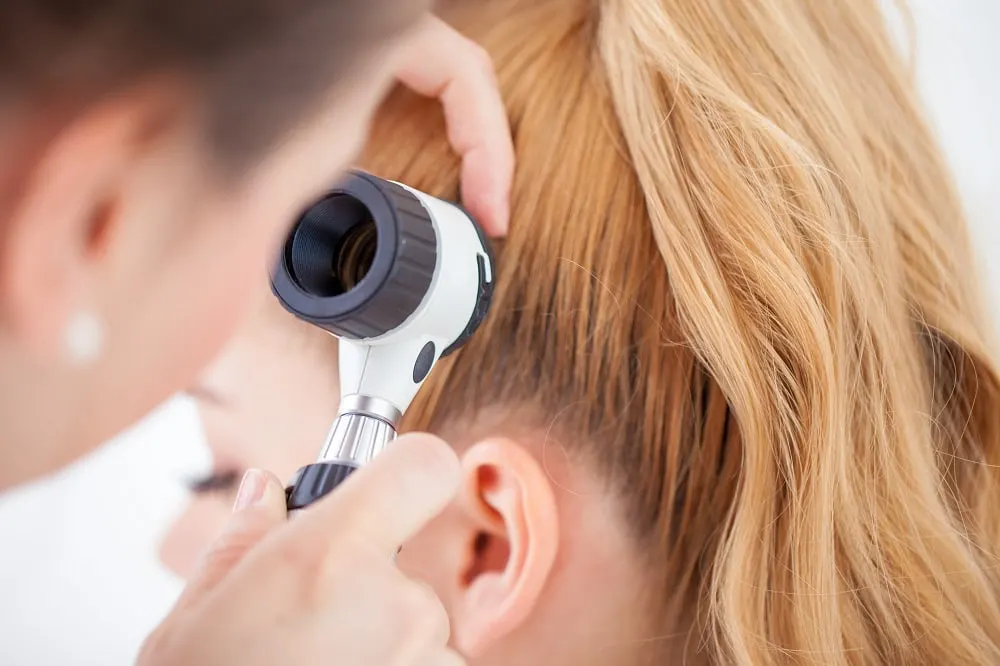Dyeing your hair is a quick and easy way to revamp your look. Unfortunately, hair can get damaged and sometimes fall out after dyeing.
Coloring hair has become an increasingly popular practice over the last decade. A recent study found that one in three women have dyed their hair—and the vast majority dye their hair every four to six weeks. It became even more popular during quarantine when most people had little else to do.
While box dyes and affordable options have made it easier than ever to DIY, few consumers know of the damage that dye can do to one’s hair—and how to fix it.
If your hair is falling out at the roots after dyeing it, use this guide to resolve the problem.
Is Hair Falling Out At the Root After Dyeing Normal?
No! Hair falling out at roots after dyeing is not normal.
You’ve likely noticed some breakage or weakness if you routinely dye your hair. While some breakage after dyeing is regular, your hair shouldn’t consistently fall out at the root.
Hair’s unique structure makes it easier to dye and more vulnerable to damage. Each strand consists of a shaft and root. The shaft has scales that protect the proteins underneath. Because dye pries open these scales to create color, it can damage proteins. Damage to proteins can lead to break and splitting.
Most hair loss after dyeing is caused by this breakage rather than actual hair loss. If your hair is falling out at the root—rather than breaking off or splitting—the problem requires more attention.
Why Does Hair Fall Out at the Roots After Dyeing?

There are several reasons your hair may be falling out.
The Dye
Dyeing hair is a relatively damaging process, to begin with. The hair dye chemicals can strip your hair’s protective oils and proteins. This weakens the hair and can cause it to break—or fall out.
Product overuse or incorrect application can lead to root hair loss after dyeing. When the dye is used incorrectly or in excessive amounts, it can harm the cuticle and weaken the strands near its source, making them more vulnerable to breakage.
Pulling & Scrubbing
Additionally, dyeing hair typically requires lots of scrubbing and manipulation of the scalp. This can cause the hair to dislodge at the root.
Just like an iceberg, hair is mainly composed of its root. Although the shaft is the part you can see, most of the hair’s structure is underneath the skin. Hair can fall out if the follicle in the root is damaged or weakened by pulling or scrubbing.
Medical Condition
Lastly, you may experience hair loss due to a rare condition called Allergic Telogen Effluvium. This rare condition occurs when a person is allergic to the chemicals in hair dye. As a result, they can lose hair at the root because of an allergic reaction.
If none of these situations apply to you, you may visit a hair specialist or doctor to determine the cause. Your hair may be falling out for an entirely different reason—such as stress or an underlying condition.
How to Stop Hair Fall At Roots After Dyeing It?
If your hair is falling out at the roots, you may feel stressed and wonder what to do.
Thankfully, there are several steps you can take to remedy the situation. Follow the steps below to address your hair loss before the problem worsens.
Treat Your Hair With Care

If your hair is falling out, that means the root is weak. You’ll need to exercise special care when washing your hair. Be gentle with it and avoid harsh scrubbing or rubbing.
You should also consider wearing a protective cap or bonnet when sleeping, since tossing and turning can cause further hair loss.
Remember to use a hairbrush that is gentle on your hair. Many people with fragile hair prefer soft boars’ bristle hairbrushes. Lastly, avoid using elastic bands, tight headbands, or clips on your hair. You can choose a gentler option, like a scrunchie instead.
Stop Dyeing It
The first step to preventing hair loss is to stop dyeing your hair.
Dye is a stressor for hair; once you stop dyeing it, your hair will begin to repair itself. If the problem was with the dye, you should notice your hair becoming healthier within three to six months.
If you need to continue dyeing your hair, you can experiment with vegan dyes that contain few chemicals. You can also use semi-permanent or temporary dye to color your hair if necessary.
Use Restorative Treatments

Treatments can help strengthen and protect your hair from breakage. Because most of what we perceive as hair loss is breakage, this may be an excellent step. However, such treatments may not remedy the situation if your hair falls out at the root.
Consider using hydrating and strengthening masks. You can also use a leave-in conditioning treatment to protect your hair further. Find enhancing shampoo and conditioner that caters to damaged or colored hair.
Make Changes in Your Nutrition

If dyeing your hair has made it fall out at the root, it likely had structural damage from the beginning. While hair can be weak for many reasons, there are quick and easy fixes you can implement to strengthen it.
First, consider taking supplements or vitamins to strengthen your hair. Many accessories include keratin or biotin, which can protect you from damage.
Then, consider making changes to your diet. Certain foods can improve the strength and quality of your hair. Examples include:
- Salmon
- Guava
- Spinach
- Greek Yogurt
- Poultry
- Cereal (Iron-Fortified)
Consider Environmental Factors
Your last step should be to consider factors in your environment that might be causing breakage or damage.
For example, exposure to certain chemicals or harsh minerals in your hair. You can use a shower filter to resolve this issue—most are affordable and readily available online.
If you often expose your hair to sun, salt, or other stressors, consider adjusting your routines and behaviors to protect your hair.
Smoking and other behaviors can cause hair loss, so consider every angle.
Visit a Doctor

If you have Telogen Effluvium, you may need treatment to preserve and restore your hair. You might also suffer from stress that can significantly impact your hair’s integrity, causing it to fall out.
A hair specialist or doctor can help you with this condition, prescribing medication and/or specialized shampoos to help restore your hair.
Thankfully, hair typically grows back within three to six months without treatment—but you’ll have to address the stressors and environmental conditions that prompted the hair loss.
Summary
- Hair falling out at the root after dyeing is not normal and is usually attributed to breakage rather than actual hair loss.
- Chemicals in the dye, incorrect application or overuse can lead to root hair loss.
- Physical manipulation, like scrubbing and pulling during the dyeing process can also cause hair to fall out.
- A rare condition called Allergic Telogen Effluvium can cause hair loss due to an allergic reaction to dye.
- To remedy the situation, be gentle with your hair, avoid harsh scrubbing, and consider stopping dyeing or using gentler dyes.
- Restorative treatments like hydrating masks and leave-in conditioners can help.
- Nutritional supplements like keratin or biotin and a diet rich in hair-strengthening foods like salmon and spinach can improve hair quality.
- Using a shower filter can reduce exposure to harsh minerals, and protecting your hair from environmental stressors like sun and salt is beneficial.
- If hair continues to fall out, consult a hair specialist or doctor for diagnosis and treatment.
- Recovery is usually within three to six months if the underlying issues are addressed.
Your hair should not fall out at the root after you dye it. While you might experience breakage—which many people mistake for loss at the root—significant hair loss should not occur.
You can resolve the situation by using treatments and therapies for your hair, modifying your diet, and addressing environmental factors. If the problem persists, visit a doctor.
